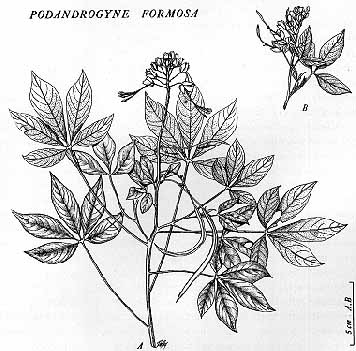
Goals and Research Efforts-Plant systematists study relationships among plant species to reveal the patterns and processes of their evolution. This knowledge then is used to produce floras, taxonomic revisions, and various phylogenetic studies. Additionally, plant systematists contribute to conservation of plants and preservation of their habitats, and so assist in monitoring endangered and threatened species. Finally,
 |
|---|
| Podandrogyne formosa. (A) Male flowers and young fruit and (B) female flowers. From: T.S. Cochrane. 1978. Podandrogyne formosa (Capparidaceae), a new species from Central America. Brittonia 30: 405-410. |
Education. It is an enormous task to document the Earth's biodiversity of plant species, to clarify relationships among species and various plant groups, and to provide biologically valid information on which to base sound conservation, forestry, and agricultural practices. All this requires specialized training in a variety of disciplines. Basic botanical training at both the undergraduate and graduate levels is essential. Clearly, the next generation of biologists must be trained suitably, not only to enable them to continue to inventory and characterize the half million known taxa, but to discover, describe, and document new species.
Most respondents to the survey indicated that an increased effort in science education in general would ultimately help our discipline. Thus, professional societies should vigorously strive to improve funding for science education from elementary through postgraduate levels. Well-supported plant systematics graduate programs-including libraries, active field exploration, and herbaria-are essential to encourage the best life science students to choose plant systematics as a career.
Public Awareness. Among the most significant concerns expressed by systematists were the need to make the general public aware (1) of the pressing issue of the worldwide loss of biodiversity, (2) of the inadequacy and limitations of current funding for conservation and preservation, and (3) of the urgency to inventory and study plant species yet to be discovered before they are lost to habitat destruction.
Funding, Resources and Limitations. Most respondents indicated that they are operating their research programs at a "severely underfunded level" but nevertheless are making limited, significant contributions to systematics on a "shoestring" budget. Much concern was expressed about the relative levels of funding for traditional systematic research as opposed to studies based upon considerably more costly molecular techniques and about the consequent, inequitable distribution of available resources among researchers. Support for collections-based (herbaria) research is also a priority among plant systematists, especially as such collections are repositories of DNA, including that of extinct species. A serious problem is how to support research that expands the discipline's frontiers both methodologically and philosophically, while at the same time continuing to support projects that use existing, proven methods to do research on the dauntingly large number of plants yet to be studied. Improved support for graduate education is essential to the long-term health of the discipline.
Future Concerns. The future of plant systematics as a discipline must be based on its central position among botanical disciplines. Systematists both rely on and contribute to studies in many related botanical disciplines. Systematics will continue to play an integral role in all botanical studies, especially ecological; as a discipline, it is particularly critical for understanding the urgent problems of conservation and loss of biodiversity. Only scientists with sufficient training in systematics can inventory and characterize whole floras and newly discovered taxa and integrate this information into the continually expanding database of botanical knowledge.
Among the most significant concerns of the future of plant systematics are the decreased commitment by universities and colleges for teaching organismal biology including systematics-and the general erosion of positions as systematists are not replaced. Without continued or increased support, many systematists are pessimistic about the discipline's future, as systematists continue to retire without being replaced in departments whose emphasis is shifting away from organismal biology.
Despite limited funding, diminished support for systematics programs and the maintenance of collections, and the urgent task of inventorying the Earth's biodiversity before it is lost, most systematists remain guardedly optimistic about the future of their discipline. In fact, many view the present time as one of great excitement. The combination of molecular methods coupled with cladistic analytical techniques has rapidly pushed forward our ability to confidently assess evolutionary relationships and has powerfully reinvigorated the discipline. The basic foundations of systematic studies have been strengthened with the development of new methods, databases, and international communication and cooperation among scientists.




